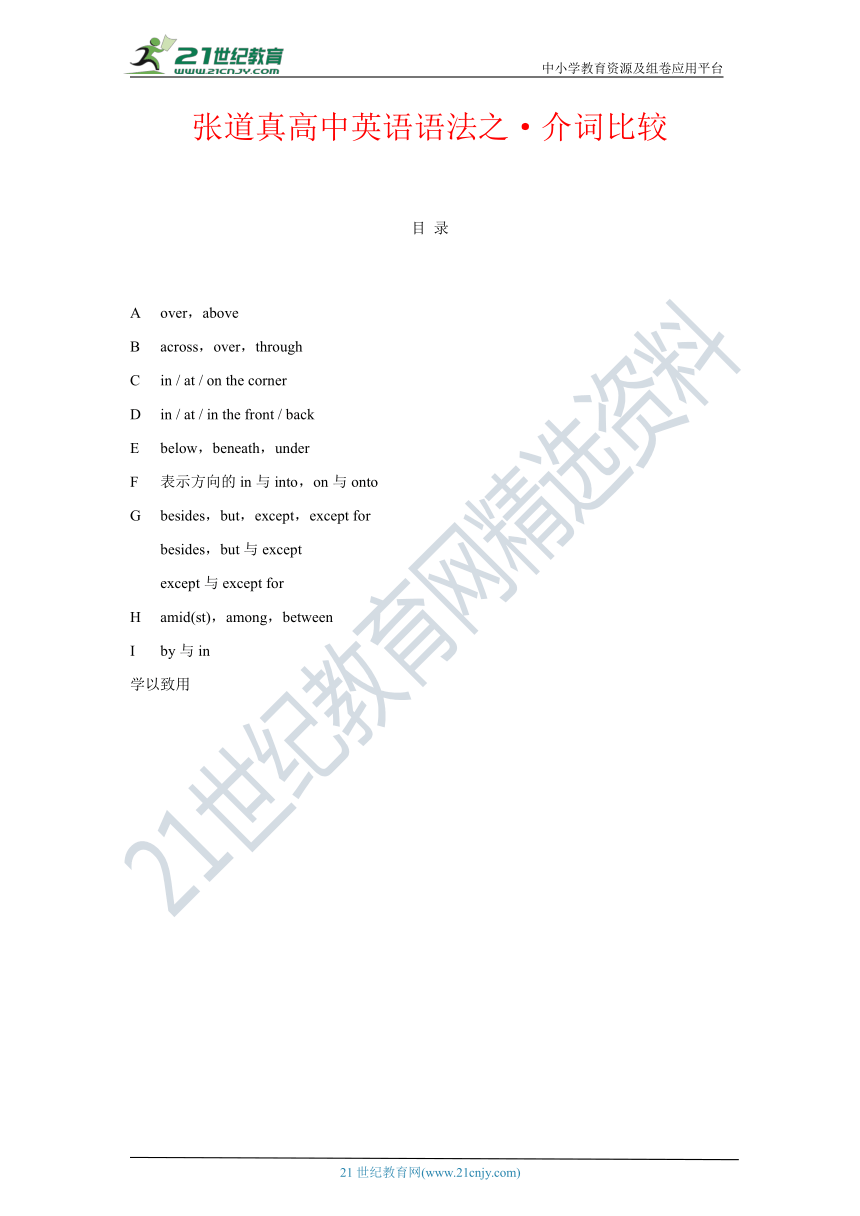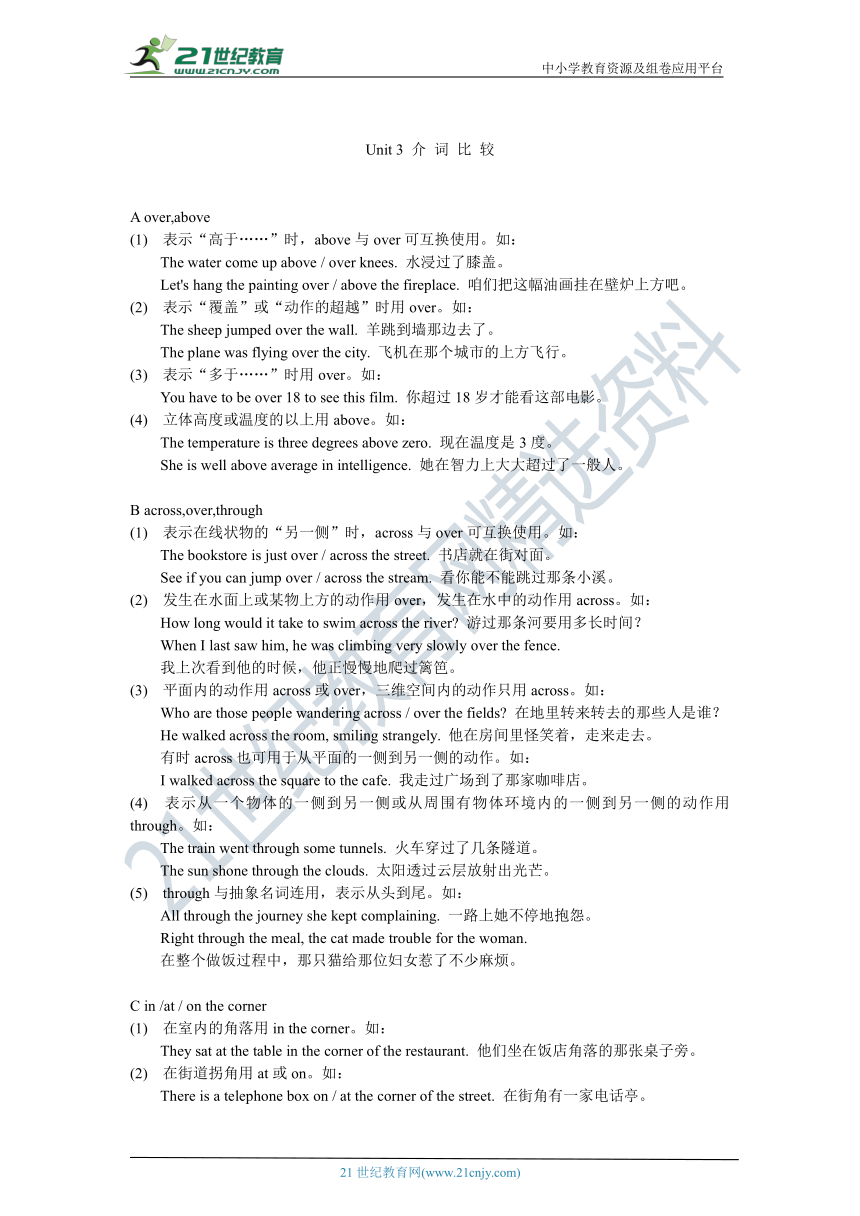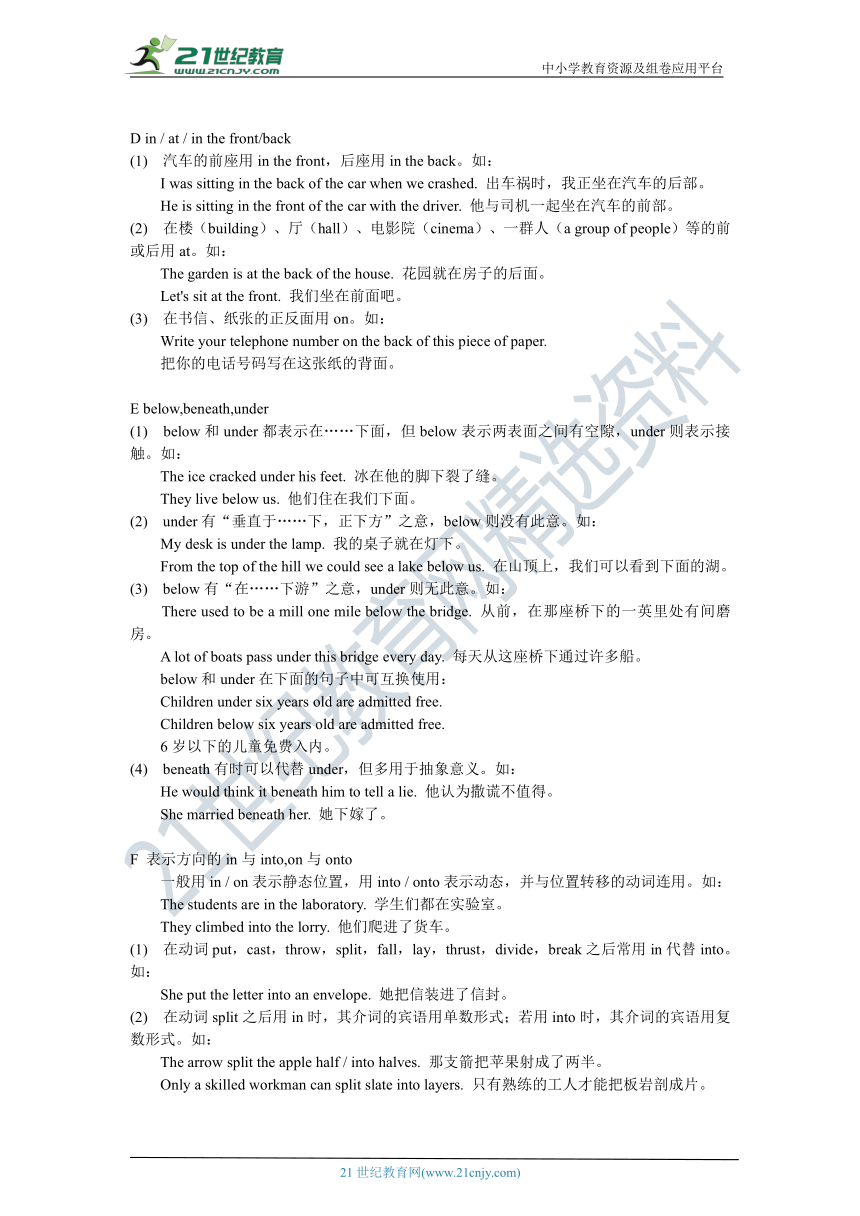高中英语语法之3介词比较
图片预览



文档简介
中小学教育资源及组卷应用平台
张道真高中英语语法之·介词比较
目 录
A over,above
B across,over,through
C in / at / on the corner
D in / at / in the front / back
E below,beneath,under
F 表示方向的in与into,on与onto
G besides,but,except,except for
????besides,but与except
????except与except for
H amid(st),among,between
I by与in
学以致用
Unit 3 介 词 比 较
A over,above
(1) 表示“高于……”时,above与over可互换使用。如:
The water come up above / over knees. 水浸过了膝盖。
Let's hang the painting over / above the fireplace. 咱们把这幅油画挂在壁炉上方吧。
(2) 表示“覆盖”或“动作的超越”时用over。如:
The sheep jumped over the wall. 羊跳到墙那边去了。
The plane was flying over the city. 飞机在那个城市的上方飞行。
(3) 表示“多于……”时用over。如:
You have to be over 18 to see this film. 你超过18岁才能看这部电影。
(4) 立体高度或温度的以上用above。如:
The temperature is three degrees above zero. 现在温度是3度。
She is well above average in intelligence. 她在智力上大大超过了一般人。
B across,over,through
(1) 表示在线状物的“另一侧”时,across与over可互换使用。如:
The bookstore is just over / across the street. 书店就在街对面。
See if you can jump over / across the stream. 看你能不能跳过那条小溪。
(2) 发生在水面上或某物上方的动作用over,发生在水中的动作用across。如:
How long would it take to swim across the river? 游过那条河要用多长时间?
When I last saw him, he was climbing very slowly over the fence.
我上次看到他的时候,他正慢慢地爬过篱笆。
(3) 平面内的动作用across或over,三维空间内的动作只用across。如:
Who a_re_tho_se people wandering across / over the fields? 在地里转来转去的那些人是谁?
He walked across the room, smiling strangely. 他在房间里怪笑着,走来走去。
有时across也可用于从平面的一侧到另一侧的动作。如:
I walked across the square to the cafe. 我走过广场到了那家咖啡店。
(4) 表示从一个物体的一侧到另一侧或从周围有物体环境内的一侧到另一侧的动作用through。如:
The train went through some tunnels. 火车穿过了几条隧道。
The sun shone through the clouds. 太阳透过云层放射出光芒。
(5) through与抽象名词连用,表示从头到尾。如:
All through the journey she kept complaining. 一路上她不停地抱怨。
Right through the meal, the cat made trouble for the woman.
在整个做饭过程中,那只猫给那位妇女惹了不少麻烦。
C in /at / on the corner
(1) 在室内的角落用in the corner。如:
They__sat_a_t the table in the corner of the restaurant. 他们坐在饭店角落的那张桌子旁。
(2) 在街道拐角用at或on。如:
There is__a_tel_ephone box on / at the corner of the street. 在街角有一家电话亭。
D in / at / in the front/back
(1) 汽车的前座用in the front,后座用in the back。如:
I was sit_ting_i_n the back of the car when we crashed. 出车祸时,我正坐在汽车的后部。
He is sitt_ing_in_ the front of the car with the driver. 他与司机一起坐在汽车的前部。
(2) 在楼(buildin_g????????????h_all)、电影院(cinema)、一群人(a group of people)等的前或后用at。如:【来源:21·世纪·教育·网】
The garden is at the back of the house. 花园就在房子的后面。www-2-1-cnjy-com
Let's sit at the front. 我们坐在前面吧。
(3) 在书信、纸张的正反面用on。如:
Write your telephone number on the back of this piece of paper. 2-1-c-n-j-y
把你的电话号码写在这张纸的背面。
E below,beneath,under
(1) below和under都表示在……下面,但below表示两表面之间有空隙,under则表示接触。如:
The ice cracked under his feet. 冰在他的脚下裂了缝。
They live below us. 他们住在我们下面。
(2) under有“垂直于……下,正下方”之意,below则没有此意。如:
My desk is under the lamp. 我的桌子就在灯下。
From the top__of_th_e hill we could see a lake below us. 在山顶上,我们可以看到下面的湖。
(3) below有“在……下游”之意,under则无此意。如:
There used to__be_a__mill one mile below the bridge. 从前,在那座桥下的一英里处有间磨房。【版权所有:21教育】
A lot of boats pass under this bridge every day. 每天从这座桥下通过许多船。
below和under在下面的句子中可互换使用:
Children under six years old are admitted free.
Children below six years old are admitted free. 21*cnjy*com
6岁以下的儿童免费入内。
(4) beneath有时可以代替under,但多用于抽象意义。如:
He would think it beneath him to tell a lie. 他认为撒谎不值得。
She married beneath her. 她下嫁了。
F 表示方向的in与into,on与onto
一般用in / on表示静态位置,用into / onto表示动态,并与位置转移的动词连用。如:
The students are in the laboratory. 学生们都在实验室。
They climbed into the lorry. 他们爬进了货车。
(1) 在动词put,_cast???t_hrow,split,fall,lay,thrust,divide,break之后常用in代替into。如:
She put the letter into an envelope. 她把信装进了信封。
(2) 在动词split之后用in时,其介词的宾语用单数形式;若用into时,其介词的宾语用复数形式。如:
The arrow split the apple half / into halves. 那支箭把苹果射成了两半。
Only a s_killed_ workman can split slate into layers. 只有熟练的工人才能把板岩剖成片。
(3) 在动_è??go???co_me,run,fly,flee,show,send,search,inquire,exam-ine,develop等之后只能用into。如:
Kelly developed into a beautiful girl. 凯莉长成了一个美丽的大姑娘。
Nina went into the clothing trade. 尼娜做服装生意。
on表示静止的位置,也可表示移动位置;若移动的位置由低到高变化则用onto。如:
We lifted him onto the table. 我们把他抱到桌子上。
G besides,but,except,except for
1. besides,but与except
(1) 在肯定句中,be_sides???_为“除……之外还……”(包括曾提到的对象),but,except意为“除……之外”(不包括曾提到的对象)。如:
Besides English, we study mathematics. 除了英语以外,我们还学习数学。
We have gathered all the crops except beans. 除了大豆以外,我们把所有的庄稼都收完了。
(2) 在否定句中,其意义相同。如:
She knew nothing besides / except that he was a doctor. 【来源:21cnj*y.co*m】
她除了知道他是个医生外,其他的什么都不知道。
I didn't have any supper except a piece of bread. 我晚饭只吃了一块面包。
(3) except之前,有实义动词do时,后面的不定式省to,没有do时则要带to。如:
He demanded nothing of her except to be there. 除了去那里,他没有要求她做任何事。
There was little I could do except wait. 除了等待,我几乎什么都不能做。
(4) 如果没有实义动词do,besides后习惯用动词-ing形式,but和except后习惯用带to的不定式。如:21*cnjy*com
Besides _helpin_g their parents to gather in the wheat, the students taught them to read and write. 除了帮父母收麦子外,这些学生还教他们读书、写字。
The enemy had no choice except to lay down their arms.
敌人没有别的选择,只有放下武器投降。
(5) 在表示“_é?¤?¤?????????????_,but和except相同,但用except较正式。except侧重于“有例外”,but侧重于“几乎全部”。如:
We are all here except / but Mary. 除了玛丽外,我们都在这儿。
但在介词短语、名词性从句前多用except。如:
The window is never opened except in summer. 这个窗户只有在夏天打开。
I know nothing about him except that he lives in London. 【出处:21教育名师】
我除了知道他住在伦敦外,其他的什么也不知道。
(6) but通常只用_??¨who???w_here,what,all,no,nothing,nobody,any-body,anything,everything,nowhere之后。如:
All but one man were wounded. 除了一个男人以外,其余的人都受伤了。
Nothing but disaster would come from such a plan. 这样的计划只会造成灾难。
2. except与except for
(1) except表示“_é?¤?¤???????ex_cept for表示“例外”。无同类词语时用except for;前后有同类词语时用except。如: 21世纪教育网版权所有
Your composition is good except for a few spelling mistakes.
除了几处的拼写错误,你的作文还是很好的。
All the tables are occupied except the one in the corner.
除了角落的这张桌子,其余的都被占用了。
(2) except只能放在句中,而except for可放在句首或句中。如:
Nobody knows the answer except Mary. 除了玛丽,没有人知道这个答案。
The classroom w_as_sil_ent, except for the busy scatching of pens on paper.
除了钢笔写在纸上发出的嚓嚓声以外,教室里一片寂静。
(3) except之前的句子通常是否定的,而except for之前的句子通常是肯定的。如:
There are no one in the street except the policemen on duty.
The streets were deserted except for the policemen on duty.www.21-cn-jy.com
除了值勤的警察,大街上什么人也没有。
但except for短语出现在句首时,后面的句子也可以是否定的。如:
Except for the policemen on duty, there was no one in the streets.
除了值勤的警察,大街上什么人也没有。
H amid(st),among,between
(1) amid_st????????????_数名词的复数形式,也可以接表示质量、性质等的不可数名词;而among和between只能接人或物的可数名词,不能接抽象的单、复数名词。如:
We groped amidst the darkness. 我们在黑暗中摸索。
He stood firm admist temptations. 他不被种种诱惑所动摇。
There is honour among thieves. 盗亦有道。
(2) among指处于易分辨的事物中;amid指处于混杂的事物中。如:
Sandy is amid the crowd. 桑迪淹没在人群之中。
Roger is among the crowd. 罗杰在人群里。
(3) among与between若用于同类事物时,between用于两者之间;among用于三者或三者以上。如:21cnjy.com
The girl is standing between a woman and a child. 这个女孩站在妇女和孩子之间。
Mother is sitting among her children. 母亲坐在她的孩子们中间。21·世纪*教育网
I by与in
两者均可表示“用,以”,_?????¨????????????_by常接动名词,表示以某种方式做某事;in后接名词,表示用某种工具或某物做某事。in与way构成短语in this / that / a...way,表示“以……方法”,有时还可与一些抽象化的名词搭配,表示用某种方式、语言、风格等。如:
He wrote the letter in English. 他用英语写了这封信。
(1) by+通讯工具(无冠词,单数)→通讯方式
The letter was sent by express. 这封信是寄快递。
(2) by+交通工具(无冠词,单数)→交通方式
Will you travel by sea or by air? 你们乘飞机还是乘船旅行?
(3) by+其他名词(无冠词,单、复数)→方式、方法
如果用in,on等表示通讯方式,须在名词前加the;表示交通方式,须在名词前加a或an。如:
She will go to workby bus. / on a bus. 她将坐公共汽车去上班。21·cn·jy·com
_21?????????è?????(www.21cnjy.com)_
张道真高中英语语法之·介词比较
目 录
A over,above
B across,over,through
C in / at / on the corner
D in / at / in the front / back
E below,beneath,under
F 表示方向的in与into,on与onto
G besides,but,except,except for
????besides,but与except
????except与except for
H amid(st),among,between
I by与in
学以致用
Unit 3 介 词 比 较
A over,above
(1) 表示“高于……”时,above与over可互换使用。如:
The water come up above / over knees. 水浸过了膝盖。
Let's hang the painting over / above the fireplace. 咱们把这幅油画挂在壁炉上方吧。
(2) 表示“覆盖”或“动作的超越”时用over。如:
The sheep jumped over the wall. 羊跳到墙那边去了。
The plane was flying over the city. 飞机在那个城市的上方飞行。
(3) 表示“多于……”时用over。如:
You have to be over 18 to see this film. 你超过18岁才能看这部电影。
(4) 立体高度或温度的以上用above。如:
The temperature is three degrees above zero. 现在温度是3度。
She is well above average in intelligence. 她在智力上大大超过了一般人。
B across,over,through
(1) 表示在线状物的“另一侧”时,across与over可互换使用。如:
The bookstore is just over / across the street. 书店就在街对面。
See if you can jump over / across the stream. 看你能不能跳过那条小溪。
(2) 发生在水面上或某物上方的动作用over,发生在水中的动作用across。如:
How long would it take to swim across the river? 游过那条河要用多长时间?
When I last saw him, he was climbing very slowly over the fence.
我上次看到他的时候,他正慢慢地爬过篱笆。
(3) 平面内的动作用across或over,三维空间内的动作只用across。如:
Who a_re_tho_se people wandering across / over the fields? 在地里转来转去的那些人是谁?
He walked across the room, smiling strangely. 他在房间里怪笑着,走来走去。
有时across也可用于从平面的一侧到另一侧的动作。如:
I walked across the square to the cafe. 我走过广场到了那家咖啡店。
(4) 表示从一个物体的一侧到另一侧或从周围有物体环境内的一侧到另一侧的动作用through。如:
The train went through some tunnels. 火车穿过了几条隧道。
The sun shone through the clouds. 太阳透过云层放射出光芒。
(5) through与抽象名词连用,表示从头到尾。如:
All through the journey she kept complaining. 一路上她不停地抱怨。
Right through the meal, the cat made trouble for the woman.
在整个做饭过程中,那只猫给那位妇女惹了不少麻烦。
C in /at / on the corner
(1) 在室内的角落用in the corner。如:
They__sat_a_t the table in the corner of the restaurant. 他们坐在饭店角落的那张桌子旁。
(2) 在街道拐角用at或on。如:
There is__a_tel_ephone box on / at the corner of the street. 在街角有一家电话亭。
D in / at / in the front/back
(1) 汽车的前座用in the front,后座用in the back。如:
I was sit_ting_i_n the back of the car when we crashed. 出车祸时,我正坐在汽车的后部。
He is sitt_ing_in_ the front of the car with the driver. 他与司机一起坐在汽车的前部。
(2) 在楼(buildin_g????????????h_all)、电影院(cinema)、一群人(a group of people)等的前或后用at。如:【来源:21·世纪·教育·网】
The garden is at the back of the house. 花园就在房子的后面。www-2-1-cnjy-com
Let's sit at the front. 我们坐在前面吧。
(3) 在书信、纸张的正反面用on。如:
Write your telephone number on the back of this piece of paper. 2-1-c-n-j-y
把你的电话号码写在这张纸的背面。
E below,beneath,under
(1) below和under都表示在……下面,但below表示两表面之间有空隙,under则表示接触。如:
The ice cracked under his feet. 冰在他的脚下裂了缝。
They live below us. 他们住在我们下面。
(2) under有“垂直于……下,正下方”之意,below则没有此意。如:
My desk is under the lamp. 我的桌子就在灯下。
From the top__of_th_e hill we could see a lake below us. 在山顶上,我们可以看到下面的湖。
(3) below有“在……下游”之意,under则无此意。如:
There used to__be_a__mill one mile below the bridge. 从前,在那座桥下的一英里处有间磨房。【版权所有:21教育】
A lot of boats pass under this bridge every day. 每天从这座桥下通过许多船。
below和under在下面的句子中可互换使用:
Children under six years old are admitted free.
Children below six years old are admitted free. 21*cnjy*com
6岁以下的儿童免费入内。
(4) beneath有时可以代替under,但多用于抽象意义。如:
He would think it beneath him to tell a lie. 他认为撒谎不值得。
She married beneath her. 她下嫁了。
F 表示方向的in与into,on与onto
一般用in / on表示静态位置,用into / onto表示动态,并与位置转移的动词连用。如:
The students are in the laboratory. 学生们都在实验室。
They climbed into the lorry. 他们爬进了货车。
(1) 在动词put,_cast???t_hrow,split,fall,lay,thrust,divide,break之后常用in代替into。如:
She put the letter into an envelope. 她把信装进了信封。
(2) 在动词split之后用in时,其介词的宾语用单数形式;若用into时,其介词的宾语用复数形式。如:
The arrow split the apple half / into halves. 那支箭把苹果射成了两半。
Only a s_killed_ workman can split slate into layers. 只有熟练的工人才能把板岩剖成片。
(3) 在动_è??go???co_me,run,fly,flee,show,send,search,inquire,exam-ine,develop等之后只能用into。如:
Kelly developed into a beautiful girl. 凯莉长成了一个美丽的大姑娘。
Nina went into the clothing trade. 尼娜做服装生意。
on表示静止的位置,也可表示移动位置;若移动的位置由低到高变化则用onto。如:
We lifted him onto the table. 我们把他抱到桌子上。
G besides,but,except,except for
1. besides,but与except
(1) 在肯定句中,be_sides???_为“除……之外还……”(包括曾提到的对象),but,except意为“除……之外”(不包括曾提到的对象)。如:
Besides English, we study mathematics. 除了英语以外,我们还学习数学。
We have gathered all the crops except beans. 除了大豆以外,我们把所有的庄稼都收完了。
(2) 在否定句中,其意义相同。如:
She knew nothing besides / except that he was a doctor. 【来源:21cnj*y.co*m】
她除了知道他是个医生外,其他的什么都不知道。
I didn't have any supper except a piece of bread. 我晚饭只吃了一块面包。
(3) except之前,有实义动词do时,后面的不定式省to,没有do时则要带to。如:
He demanded nothing of her except to be there. 除了去那里,他没有要求她做任何事。
There was little I could do except wait. 除了等待,我几乎什么都不能做。
(4) 如果没有实义动词do,besides后习惯用动词-ing形式,but和except后习惯用带to的不定式。如:21*cnjy*com
Besides _helpin_g their parents to gather in the wheat, the students taught them to read and write. 除了帮父母收麦子外,这些学生还教他们读书、写字。
The enemy had no choice except to lay down their arms.
敌人没有别的选择,只有放下武器投降。
(5) 在表示“_é?¤?¤?????????????_,but和except相同,但用except较正式。except侧重于“有例外”,but侧重于“几乎全部”。如:
We are all here except / but Mary. 除了玛丽外,我们都在这儿。
但在介词短语、名词性从句前多用except。如:
The window is never opened except in summer. 这个窗户只有在夏天打开。
I know nothing about him except that he lives in London. 【出处:21教育名师】
我除了知道他住在伦敦外,其他的什么也不知道。
(6) but通常只用_??¨who???w_here,what,all,no,nothing,nobody,any-body,anything,everything,nowhere之后。如:
All but one man were wounded. 除了一个男人以外,其余的人都受伤了。
Nothing but disaster would come from such a plan. 这样的计划只会造成灾难。
2. except与except for
(1) except表示“_é?¤?¤???????ex_cept for表示“例外”。无同类词语时用except for;前后有同类词语时用except。如: 21世纪教育网版权所有
Your composition is good except for a few spelling mistakes.
除了几处的拼写错误,你的作文还是很好的。
All the tables are occupied except the one in the corner.
除了角落的这张桌子,其余的都被占用了。
(2) except只能放在句中,而except for可放在句首或句中。如:
Nobody knows the answer except Mary. 除了玛丽,没有人知道这个答案。
The classroom w_as_sil_ent, except for the busy scatching of pens on paper.
除了钢笔写在纸上发出的嚓嚓声以外,教室里一片寂静。
(3) except之前的句子通常是否定的,而except for之前的句子通常是肯定的。如:
There are no one in the street except the policemen on duty.
The streets were deserted except for the policemen on duty.www.21-cn-jy.com
除了值勤的警察,大街上什么人也没有。
但except for短语出现在句首时,后面的句子也可以是否定的。如:
Except for the policemen on duty, there was no one in the streets.
除了值勤的警察,大街上什么人也没有。
H amid(st),among,between
(1) amid_st????????????_数名词的复数形式,也可以接表示质量、性质等的不可数名词;而among和between只能接人或物的可数名词,不能接抽象的单、复数名词。如:
We groped amidst the darkness. 我们在黑暗中摸索。
He stood firm admist temptations. 他不被种种诱惑所动摇。
There is honour among thieves. 盗亦有道。
(2) among指处于易分辨的事物中;amid指处于混杂的事物中。如:
Sandy is amid the crowd. 桑迪淹没在人群之中。
Roger is among the crowd. 罗杰在人群里。
(3) among与between若用于同类事物时,between用于两者之间;among用于三者或三者以上。如:21cnjy.com
The girl is standing between a woman and a child. 这个女孩站在妇女和孩子之间。
Mother is sitting among her children. 母亲坐在她的孩子们中间。21·世纪*教育网
I by与in
两者均可表示“用,以”,_?????¨????????????_by常接动名词,表示以某种方式做某事;in后接名词,表示用某种工具或某物做某事。in与way构成短语in this / that / a...way,表示“以……方法”,有时还可与一些抽象化的名词搭配,表示用某种方式、语言、风格等。如:
He wrote the letter in English. 他用英语写了这封信。
(1) by+通讯工具(无冠词,单数)→通讯方式
The letter was sent by express. 这封信是寄快递。
(2) by+交通工具(无冠词,单数)→交通方式
Will you travel by sea or by air? 你们乘飞机还是乘船旅行?
(3) by+其他名词(无冠词,单、复数)→方式、方法
如果用in,on等表示通讯方式,须在名词前加the;表示交通方式,须在名词前加a或an。如:
She will go to workby bus. / on a bus. 她将坐公共汽车去上班。21·cn·jy·com
_21?????????è?????(www.21cnjy.com)_
